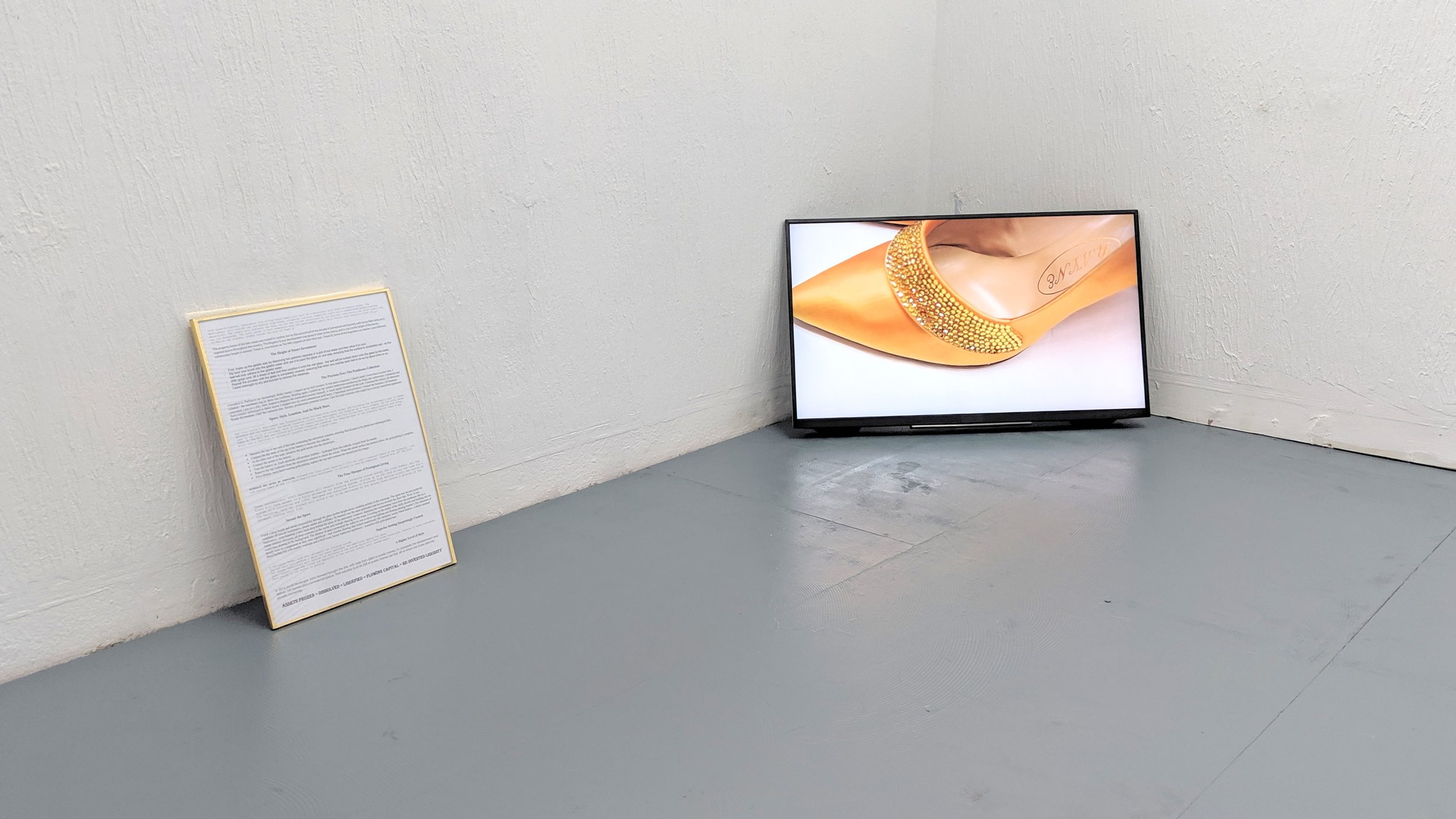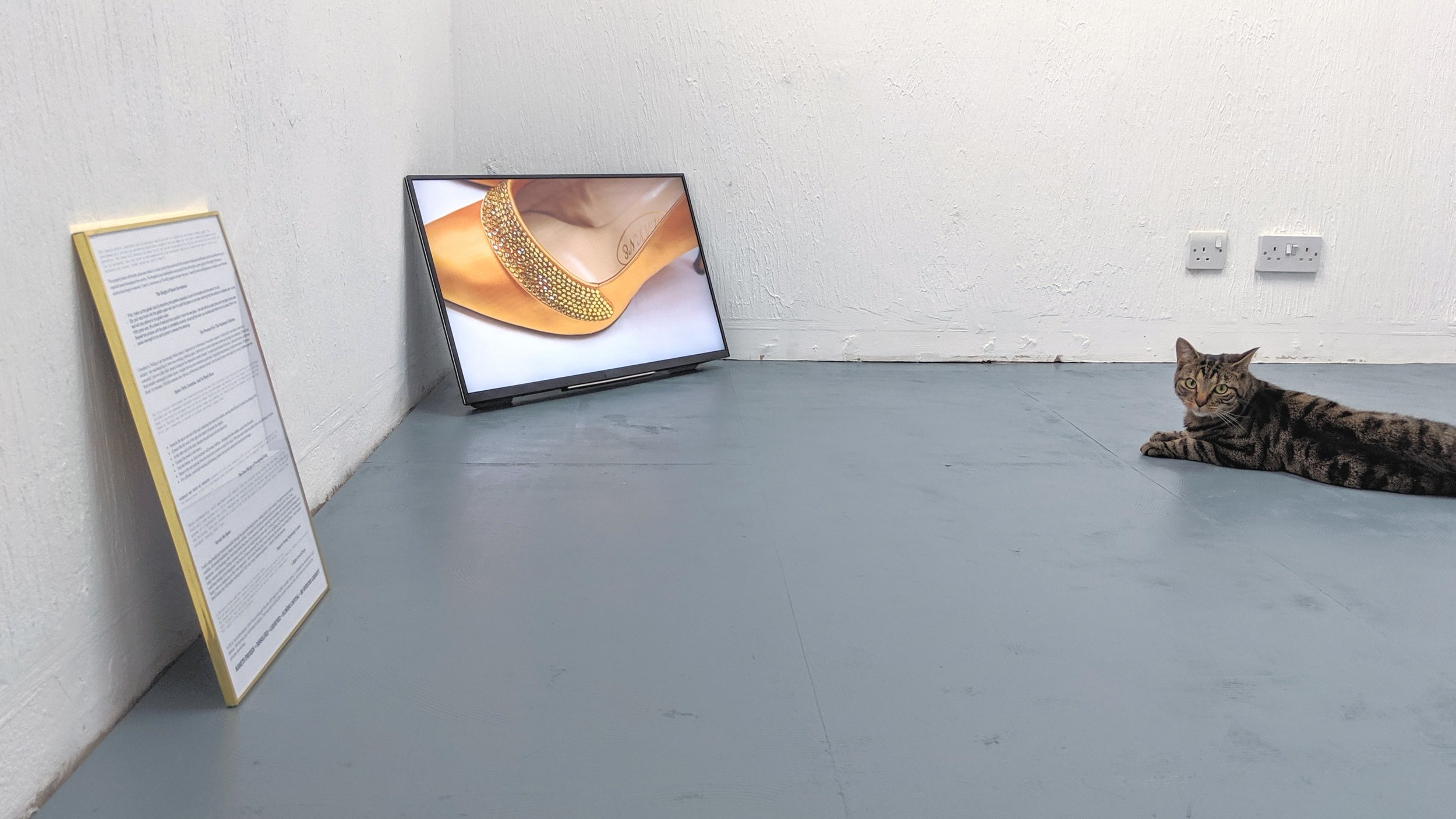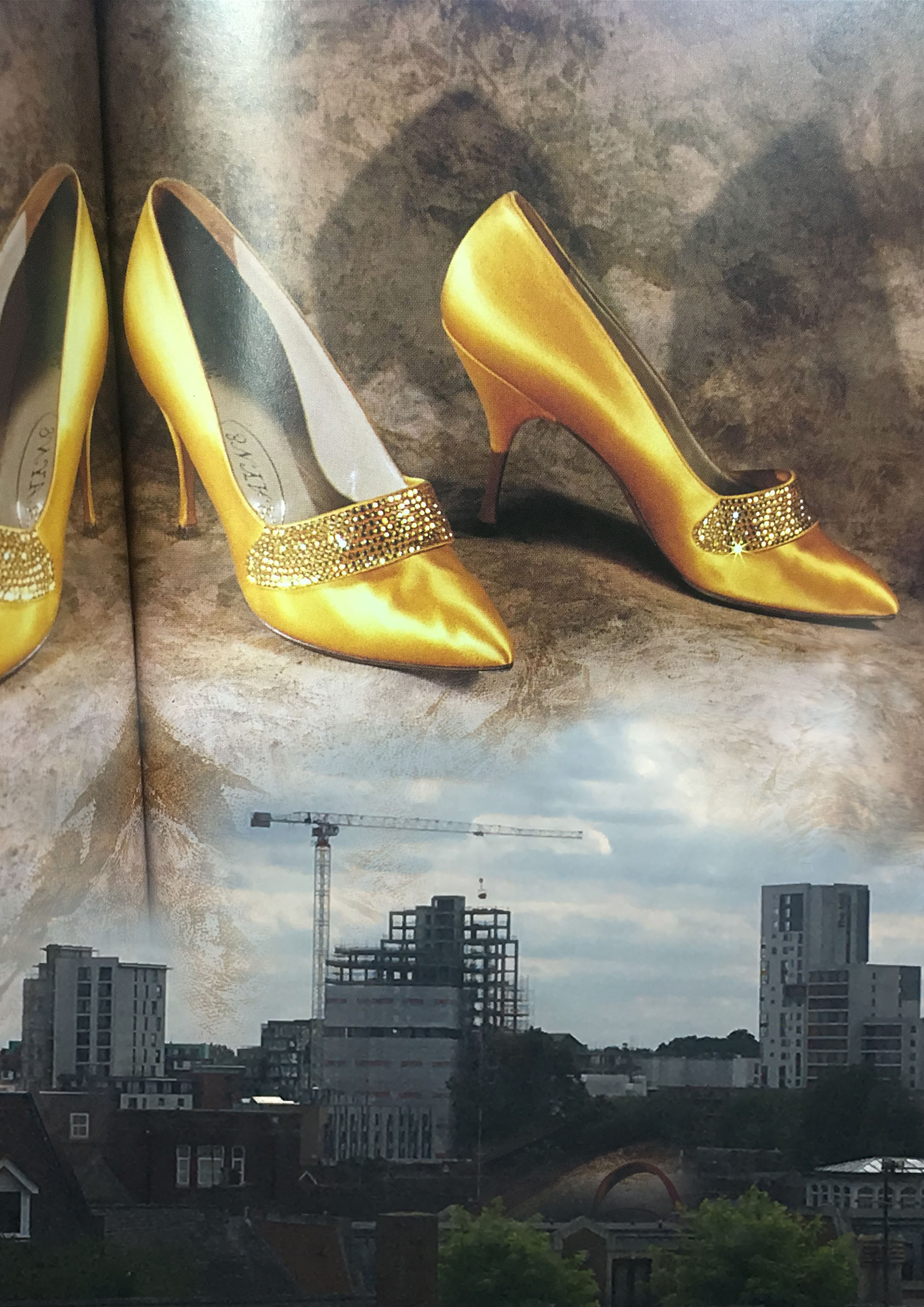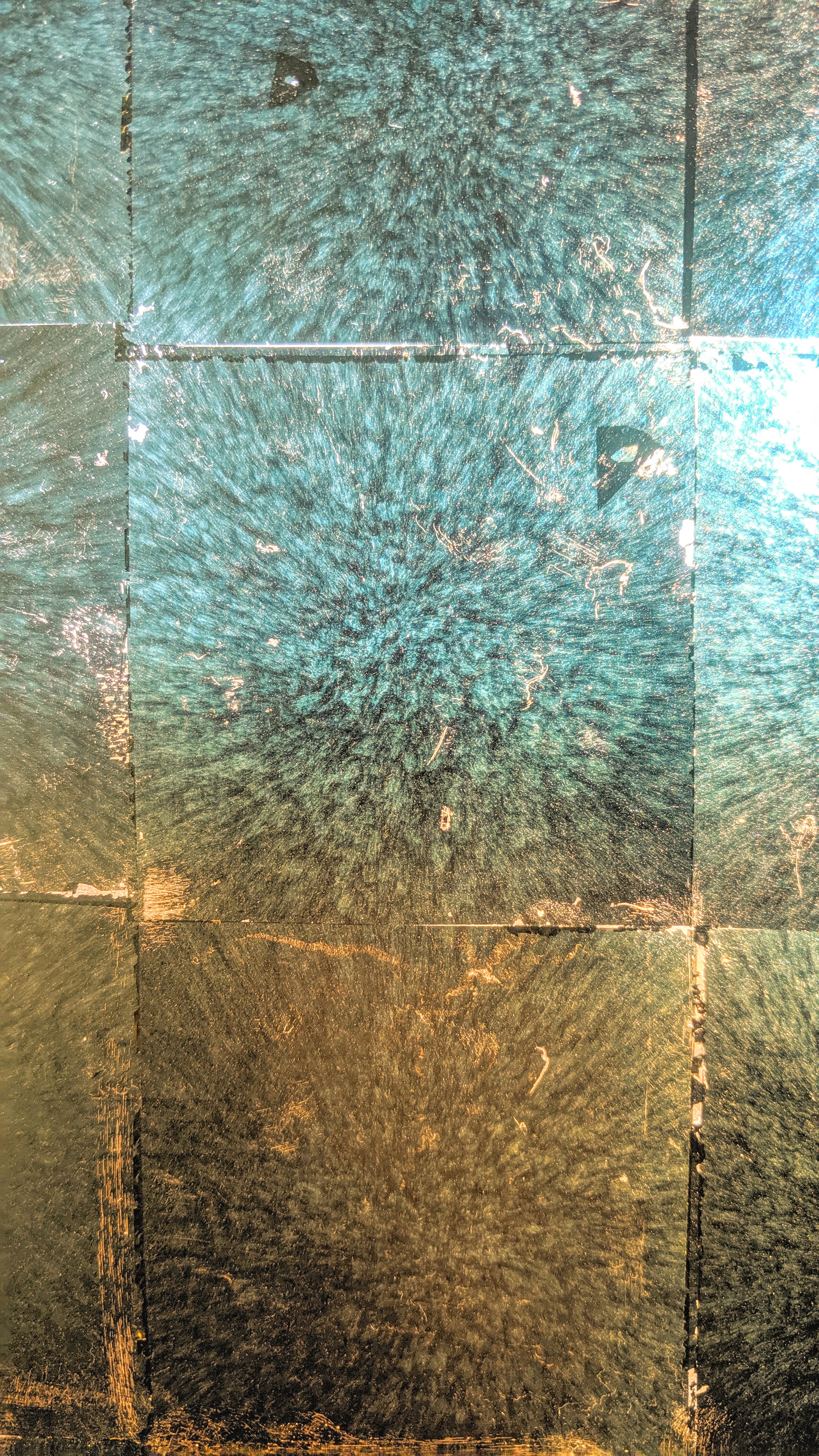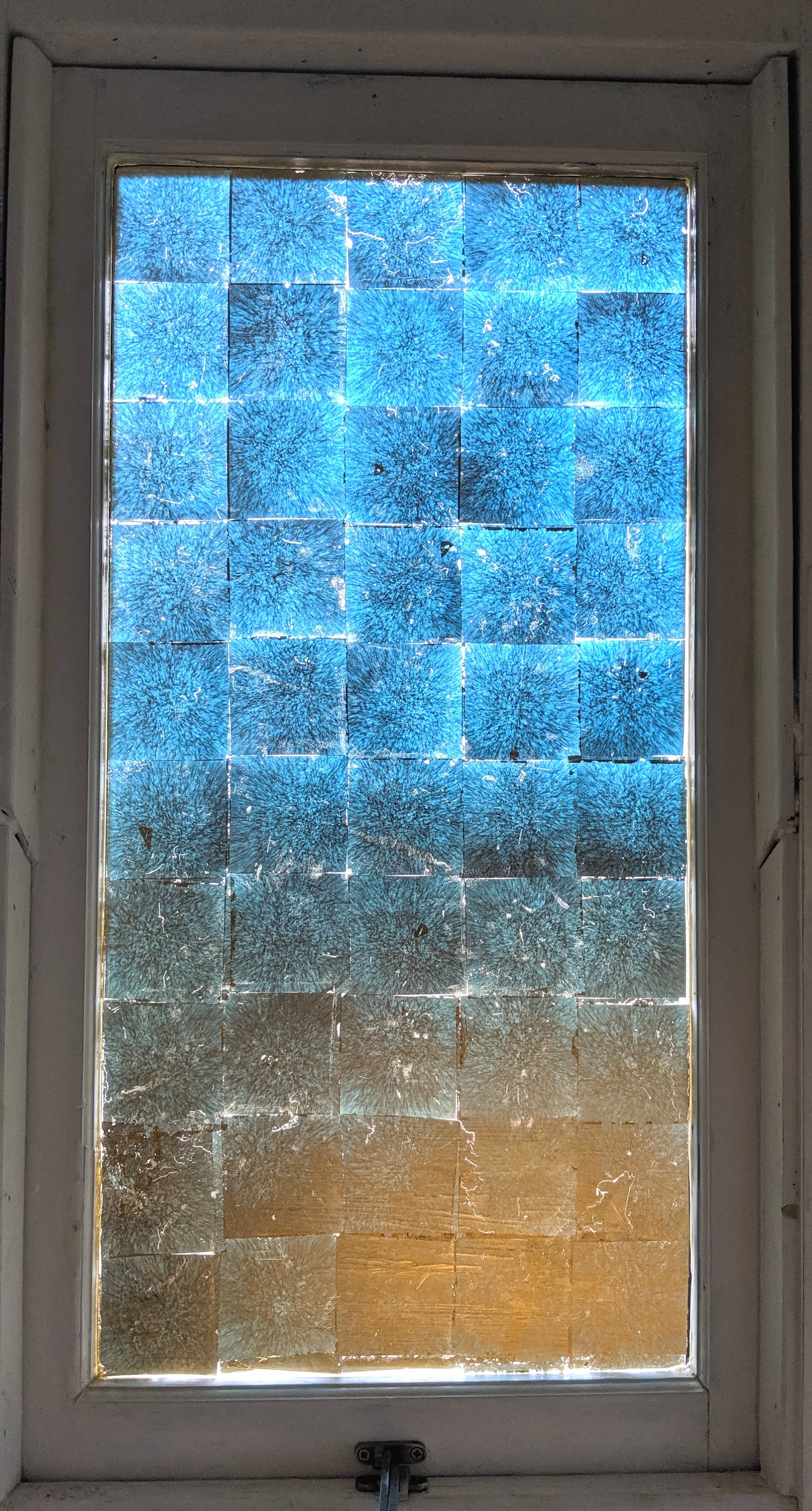Charlotte Warne Thomas
Point. Of. View
12 May - 2 June 2019
Taking as its starting point the panoramic vista from the top window of Atlas House, Point. Of. View interweaves a series of narratives surrounding Warne Thomas’ on going research into the unique materiality of gold together with her recent investigations into different aspects of Atlas House's history and surroundings.
Point. Of. View explores the potential links between the Winerack, a now infamous tower block of luxury flats on Ipswich’s skyline and Atlas House’s history as a former factory. Through a series of related works, including: an audible gilded window visible from across the neighbourhood; a semi-transparent curtain featuring a letterpress print; a short film of Rayne gold evening shoes from the V&A collection; and a text work; Warne Thomas mines gold for its rich metaphors and analogies to tease out unlikely relationships between the different elements in the exhibition.
Untitled 2019, 22ct gold leaf on window glass, audio loop
Rayne T.363:1, 2-1996 2019, HD video loop
Ghost Towers 2019, print on fabric
Capital Investment 2019, Printed text, image, acrylic, gold vinyl
---------------------------------
Perched halfway up Woodbridge Rd, Atlas House overlooks much of Ipswich town centre, it’s South-facing window affording sweeping city vistas. Emphasising this elevated viewpoint, this window is gilded in 22ct gold leaf. From outside, its subtly mirrored surface reflects the sunlight, a buttery beacon visible across the surrounding streets. Meanwhile inside, the backlit gilding appears translucent and glows with a blue-green tone. The effect is created by the unique characteristic of gold atoms to reflect back light from the red and yellow end of the spectrum (hence its rich yellow colour) whilst absorbing light from the blue-green end of the spectrum, or in this case, with just a wafer-thin layer of gold, transmitting the blue-green light, creating the surprising colour. What appears solid from the outside, mirroring the surrounding town back at itself with an opulent sheen, looks fragile and papery from within. Its function as a window is transformed; it cannot be seen through, but it can still see.
Imagining the window’s simultaneous external and internal gaze, Warne Thomas animates it with a first person monologue ruminating on its position at the top of the building, overlooking both the town and the building itself; its unique point of view. The window invites the viewers’ gaze, revelling vainly in its expensive gold surface, before reflecting on its position overlooking the Ipswich skyline, then finally contemplating Atlas House’s former incarnation as a factory, first making corsets, then, from 1949 until 1963, Rayne shoes.
Rayne is a bespoke shoe-maker with an illustrious history and a long list of highly distinguished clients, among them HM Queen Elizabeth II, Brigitte Bardot and the late Diana Princes of Wales. The HD video Rayne T.363:1, 2-1996features a pair of 1963 Rayne gold evening shoes from the V&A collection, which would have been crafted in Atlas House. The camera lingers over the shoes, seduced by their gold surface and extravagant rhinestone trimmings, gazing lasciviously over the curves of the heels and drunkenly zooming in and out on the gold silk surface. With Rayne T.363:1, 2-1996Warne Thomas invites us to luxuriate in the visual pleasure of an exquisite object, drawing out parallels between the superficial acts of donning a fancy pair of shoes and the creation of the luxury through the wafer thin layer of gold on a gilded surface.
The view of Ipswich skyline from Atlas House’s window is punctuated by a couple of high rise blocks which tower well-above the surrounding buildings. The Mill and The Winerack stand side by side, neither one complete – both legacies of the 2008 financial crash. But after spending a decade as a skeleton of steel and concrete, the fortunes of the Winerack have made a remarkable turn around. At the time of writing the first eleven of its 149 luxury apartments have gone on the market, each sold with its own parking space inside the core of the tower in its automated car-stacker. Designed and fitted by German market-leader Wohr, car-stackers are the innovative solution to vehicle storage in the world’s megacities, where space is at a premium. The Winerack, just 5 minutes from Ipswich town centre and the station, houses East Anglia’s first.
Ghost Towers, a transparent curtain dividing the Atlas House gallery from the rest of the space, features an enlarged negative print of a letterpress forme(the frame used to lay out the pages of newspapers in the printing press era) which contains a collection of headlines and straplines used to market luxury properties. Echoing the sales particulars for the Winerack, the work calls attention to the use of seductive language and hyperbole in the creation of the appearance of luxury in “luxury flats”.
The same headlines and straplines appear again in the text work Capital Investment, which further explores the nature of this language, weaving together a series of contrasting texts to tell the convoluted story of the Winerack’s notorious inception, demise and resurrection. The different narratives – some authored by the artist, others uncovered during her research – include extracts from instruction manuals for gold plating and gilding – two processes that use gold to turn otherwise ordinary substrates into luxury commodities. The creation of seductive gold surfaces by these means echoes the seductive marketing language used for “luxury flats” and articulates the superficial nature of the luxury on offer. In a visual analogy of the concept, the reverse of Capital Investment features an image of the Rayne gold evening shoes merging into the sky above the Winerack.
According to Anna Minton, the insatiable demand for luxury residential property has had dramatic effects on the UK economy and its citizens [1]. Whereas in times gone by, the wealthy would have stored their wealth by buying gold, nowadays, “luxury” properties – specifically new build towers – are instead seen as a gold standard investment, even becoming known as “safety deposit boxes in the sky” [2]. But a closer look at this so-called luxury reveals that like the micron- thick layer of gold plating, a surface layer that is much more expensive than the object it covers can give a sense of luxury and desirability for a lower price, allowing much larger profit margins. Whist every tower block is essentially just steel, concrete and glass in differing proportions, it is the finish – the surface layers and tropes of luxury (the marble worktops; gold taps; solid wood flooring; car stacker) that determine the marketability and ultimately the price of its units. Similarly the gold surface offers the chance to add a veneer of luxury and opulence to its substrate, be it a pair of shoes, a window or a set of taps.
[1] Anna Minton, Big capital : who is London for?2017, London: Penguin Books
[2] https://www.theguardian.com/commentisfree/2015/jan/25/planners-must-take-back-control-of-london
---------------------------------
Charlotte Warne Thomas is an artist, researcher and educator based in London. Her practice based PhD at Kingston University's Contemporary Art Research Centre is funded by AHRC consortium Techne. Her research seeks to explore the unique materiality of gold using historical and fictional narratives, through investigations of the transformation of gold between different states, in processes including electroplating, dissolving and precipitation. She is co-founder and curator of Peer Sessions, a post-graduate crit group supporting artists' professional development and collaborative practice.








